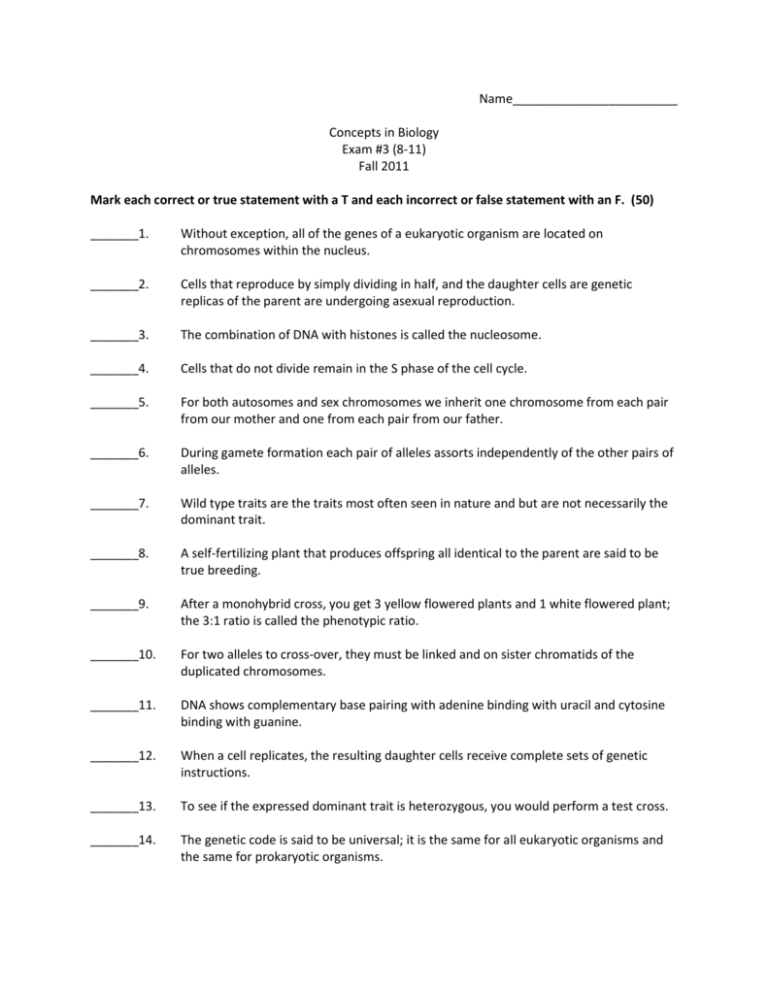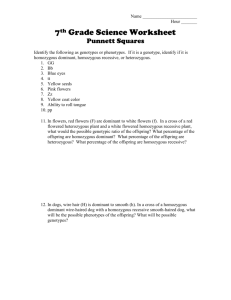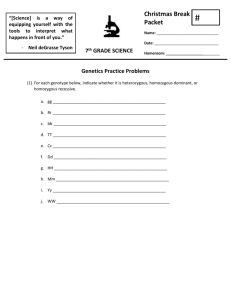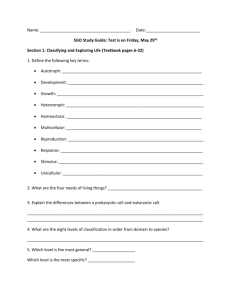Examination #3
advertisement

Name________________________ Concepts in Biology Exam #3 (8-11) Fall 2011 Mark each correct or true statement with a T and each incorrect or false statement with an F. (50) _______1. Without exception, all of the genes of a eukaryotic organism are located on chromosomes within the nucleus. _______2. Cells that reproduce by simply dividing in half, and the daughter cells are genetic replicas of the parent are undergoing asexual reproduction. _______3. The combination of DNA with histones is called the nucleosome. _______4. Cells that do not divide remain in the S phase of the cell cycle. _______5. For both autosomes and sex chromosomes we inherit one chromosome from each pair from our mother and one from each pair from our father. _______6. During gamete formation each pair of alleles assorts independently of the other pairs of alleles. _______7. Wild type traits are the traits most often seen in nature and but are not necessarily the dominant trait. _______8. A self-fertilizing plant that produces offspring all identical to the parent are said to be true breeding. _______9. After a monohybrid cross, you get 3 yellow flowered plants and 1 white flowered plant; the 3:1 ratio is called the phenotypic ratio. _______10. For two alleles to cross-over, they must be linked and on sister chromatids of the duplicated chromosomes. _______11. DNA shows complementary base pairing with adenine binding with uracil and cytosine binding with guanine. _______12. When a cell replicates, the resulting daughter cells receive complete sets of genetic instructions. _______13. To see if the expressed dominant trait is heterozygous, you would perform a test cross. _______14. The genetic code is said to be universal; it is the same for all eukaryotic organisms and the same for prokaryotic organisms. _______15. DNA polymerase enzyme initiates the replication of the leading strand of the DNA molecule. _______16. The genetic code has three start and one stop codon. _______17. The genetic code is degenerate in that a given amino acid can have more than one codon. _______18. The genetic code is unambiguous in that a given codon codes for only one amino acid. _______19. In the inducible operon, the repressor is inactive. _______20. An example of X-chromosome inactivation occurs with the calico cat (orange and black fur). _______21. Incomplete dominance occurs only in plants, never in animals. _______22. The so-called sex chromosomes contain genes for characters unrelated to maleness or femaleness. _______23. Animal viruses can possess an envelope that is made of membrane material from its host cell. _______24. A mutation that does not cause a noticeable phenotypic change is called a non-sense mutation. _______25. The anticodon triplet is complementary to the mRNA codon triplet. Select the one best answer that either defines or completes the meaning of the given statement. (50) _______1. The phase of mitosis in which the centromeres split and chromosomes move toward the opposite poles of the cell A. B. C. D. _______2. Metaphase Anaphase Prophase Telophase The phase of mitosis in which the spindle is formed and the nuclear membrane breaks down A. B. C. D. Metaphase Anaphase Prophase Telophase _______3. Crossing over occurs only during A. B. C. D. _______4. Abnormalities of sex chromosome numbers in humans include A. B. C. D. _______5. Codominance Sex linkage Incomplete dominance Polygenic inheritance Brown color is dominant over white. If you cross a heterozgous dominant brown mouse with a homozygous white mouse, what percentage of the offspring will be white? A. B. C. D. _______8. Between prophase and anaphase of mitosis Between the G1 and G2 phases of the cell cycle Between prophase I and prophase II of meiosis During the M phase of the cell cycle All the offspring of a black rooster and white hen are gray. This is most likely A. B. C. D. _______7. Turner’s syndrome Klinefelter’s syndrome XXX female All of the above are correct A biochemist measures the amount of DNA in cells growing in the laboratory. The quantity of DNA in a cell would be found to double A. B. C. D. _______6. Metaphase I Metaphase II Prophase I Anaphase I 0 25 50 75 If you cross a heterozygous brown mouse with another heterozygous brown mouse, what percentage of the offspring will be brown? A. B. C. D. 25 50 75 100 _______9. Black color is dominant over white and curly hair is dominant over straight hair. If you cross a heterozygous black curly haired mouse with another heterozygous black curly, what is the phenotypic ratio? A. B. C. D. _______10. If you cross a red-flowered (RR) plant with a white-flowered (rr) plant, you get a pinikflowered plant. If you cross two F1 plants, what is the genotypic ratio? A. B. C. D. _______11. Polygenic Codominant Incomplete dominance None of the above are correct A man who has type A blood marries a woman with type B blood. Their children could have which of the following phenotypes . Both parents are heterozygous. A. B. C. D. _______14. Pleiotrophy Incomplete dominance Polygenic inheritance Codominance If the phenotypes from a given trait show a bell-shaped curve, the trait is said to be A. B. C. D. _______13. 1 homozygous red: 2 heterozygous pink: 1 homozygous white 3 red: 1 white 2 homozygous red: 1 heterozygous pink: 1 homozygous white 2 red: 2 white ABO blood typing system is an example of A. B. C. D. _______12. 3:1 1:1 9:3:3:1 1:1:1:1 A, B, or O AB only AB or O A, B, AB, O Purple is dominant over yellow and smooth is dominant over wrinkled. If you make the following cross, what is the chance that the offspring will be purple yellow? PpSs X ppss A. B. C. D. 25 50 75 100 _______15. Using the same criteria as in #14, make the cross—PpSs X PPSS. What is the chance the offspring will be purple yellow? A. B. C. D. _______16. In the process of meiosis, the centromere splits during A. B. C. D. _______17. 2 3 4 5 The DNA sequence—ACCGTAAT would produce the following mRNA A. B. C. D. _______20. Anaphase I Telophase I Anaphase II Telophase II The genetic code is based on codons of ___ nucleotides. A. B. C. D. _______19. Metaphase I Anaphase I Anaphase II Telophase II In meiosis at the end of what stage are the cells haploid? A. B. C. D. _______18. 25 50 75 100 TGGCATTU UUAGCGUUA TTACGCTTA None of the above are correct The mutation that would most likely cause a defective gene A. B. C. D. silent base analog base substitution deletion _______21. The pieces of RNA that are removed during processing of the RNA transcript A. B. C. D. _______22. The two scientists who proposed the operon theory A. B. C. D. _______23. The DNA level transcription translation all of the above are correct Genes that regulate other groups of genes are called A. B. C. D. _______25. Griffith and Halley Franklin and Wilkins Beadle and Chase Jacob and Monod Gene regulation in eukaryotic cells can occur at A. B. C. D. _______24. Nucleosomes Histones Introns Exons dominators homeotic pleiotrophic alternative The overall process by which information flows from genes to proteins is called A. B. C. D. cellular differentiation gene expression gene operation the operon theory Choose two of the following essay questions. You may do the third question as a bonus. (20) Compare and contrast the lytic and lysogenic cycles of bacterial viruses. Make a cross between the following: TTRR X ttrr. Show the gamete types and the F1. Cross two F1s and show the gamete type, offspring, phenotypic ratio, and the Punnett square. Discuss the operon theory.







